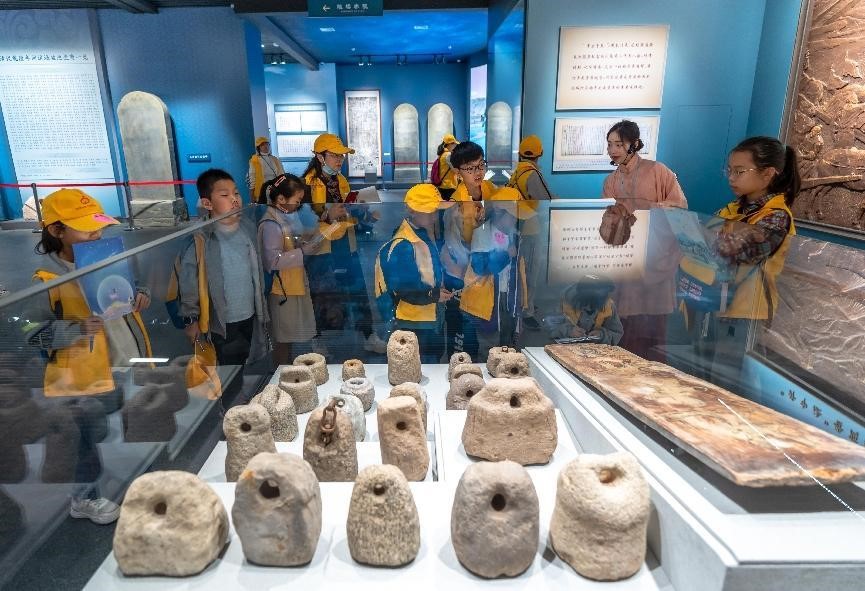Historical city makes progress in integrated development of culture, tourism

Photo shows a magnificent view of the Yellow River in Ruicheng county, Yuncheng, north China's Shanxi province, April 27, 2023. [People's Daily Online/Xue Jun]
Guan Yu, a famous general serving in the Three Kingdoms period (220-280 A.D.) of China, has long been respected as a symbol of loyalty. Today, he becomes an icon that contributes to the tourism of his hometown Yuncheng, north China's Shanxi province.
A digital museum of the deified historic figure, who's also known as Guandi, was established near the Guandi Temple in Yuncheng in September 2022. The two-story red building, equipped with holographic projection and virtual reality technologies, aims to better tell the stories of Guan Yu to more people.
Near another temple commemorating Guan's family in Yuncheng's Changping village, a Guan Yu-themed pedestrian street was also built, where hot pot, traditional noodle dishes, fried dough twists and other local food are sold.
The pedestrian street is also home to a number of crosstalk theaters and shops of cultural products. Plays themed with the Three Kingdoms are often performed on the street.
"We do our best to promote local tourism," said Wang Peng, an employee of the company that manages the pedestrian street.
According to him, the pedestrian is home to some 70 architectures built in accordance with ancient styles—from the materials to the carving and paintings on them.

Children visit a museum in Yuncheng, north China's Shanxi province, April 29, 2023. [People's Daily Online/Yan Xin]
The pedestrian street aims to demonstrate the culture related to Guandi, Wang noted, adding that five plays about Guandi have been designed and relevant cultural experience activities have been introduced on the pedestrian street.
Yuncheng was named "Hedong", meaning "East of the Yellow River," in ancient times. It is a city that enjoys a profound culture and long history. It is home to 102 major historical and cultural sites protected at the national level as well as more than 6,000 pieces of immovable cultural relics.
Over recent years, Yuncheng has been working to promote the integrated development of culture and tourism. The renowned historical city is brimming with new vitality.
The city has completed reforms of institutional mechanisms of three major state-owned tourist sites in the past couple of years, including the Guandi Temple and the Yongle Palace, which has brought new growth points to traditional tourist attractions.
Yuncheng is currently exploring more opportunities in the integrated development of culture and tourism.

Photo taken on May 1, 2023 shows a beautiful night view in a cultural park in Yuncheng, north China's Shanxi province. [People's Daily Online/Chang Qi]
For instance, a grand stage play telling the impacts of Hedong on the formation of the Chinese civilization is always in hot demand. The Yongle Palace, notable for its Yuan Dynasty (1271-1368) murals, has hosted a series of exhibitions of cultural relics to attract visitors.
Tourist attractions are emerging in Yuncheng. A highway along the Yellow River, connecting 24 national-level tourist sites, has witnessed the emergence of a number of tourist destinations, including a Yellow River-themed ecological park and a B&B cluster. A tourism belt with the unique features of southern Shanxi has taken shape.
"Yuncheng, working to optimize its tourism layout and improve its tourism services, will strive to build the highway into a superior tourism route in three years," said Chen Xiaoguang, head of Yuncheng's culture and tourism bureau.
"It's important to expand the economy in accordance with local features. The development of the culture and tourism sector must be advanced as a part of urban development, so as to meet people's expectations for better cultural lives," said Wang Zhifeng, head of Yuncheng's publicity department.
Over recent years, the city has built a number of tourist sites themed with historical figures and stories. These sites have not only brought better cultural lives to the local people, but also contributed to the development of the city's culture and tourism sector.
























